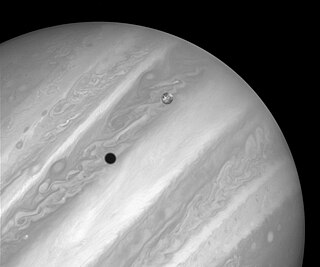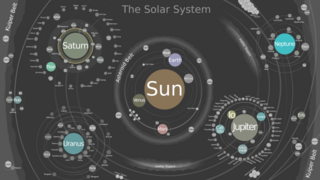
A natural satellite is, in the most common usage, an astronomical body that orbits a planet, dwarf planet, or small Solar System body. Natural satellites are colloquially referred to as moons, a derivation from the Moon of Earth.

Rhea is the second-largest moon of Saturn and the ninth-largest moon in the Solar System, with a surface area that is comparable to the area of Australia. It is the smallest body in the Solar System for which precise measurements have confirmed a shape consistent with hydrostatic equilibrium. It was discovered in 1672 by Giovanni Domenico Cassini.

Tethys, or Saturn III, is the fifth-largest moon of Saturn, measuring about 1,060 km (660 mi) across. It was discovered by Giovanni Domenico Cassini in 1684, and is named after the titan Tethys of Greek mythology.

Iapetus is the outermost of Saturn's large moons. With an estimated diameter of 1,469 km, it is the third-largest moon of Saturn and the eleventh-largest in the Solar System. Named after the Titan Iapetus, the moon was discovered in 1671 by Giovanni Domenico Cassini.

Dione, also designated Saturn IV, is the fourth-largest moon of Saturn. Its trailing hemisphere is marked by large ice cliffs called chasmata and is also darkened compared to the leading hemisphere. Based on its density, Dione’s interior is likely a combination of silicate rock and water ice in nearly equal parts by mass. The moon was discovered by Italian astronomer Giovanni Domenico Cassini in 1684 and is named after the Titaness Dione in Greek mythology.

The moons of Saturn are numerous and diverse, ranging from tiny moonlets only tens of meters across to the enormous Titan, which is larger than the planet Mercury. There are 146 moons with confirmed orbits, the most of any planet in the solar system. This number does not include the many thousands of moonlets embedded within Saturn's dense rings, nor hundreds of possible kilometer-sized distant moons that were seen through telescopes but not recaptured. Seven Saturnian moons are large enough to have collapsed into a relaxed, ellipsoidal shape, though only one or two of those, Titan and possibly Rhea, are currently in hydrostatic equilibrium. Three moons are particularly notable. Titan is the second-largest moon in the Solar System, with a nitrogen-rich Earth-like atmosphere and a landscape featuring river networks and hydrocarbon lakes. Enceladus emits jets of ice from its south-polar region and is covered in a deep layer of snow. Iapetus has contrasting black and white hemispheres as well as an extensive ridge of equatorial mountains among the tallest in the solar system.
This is a directory of lists of geological features on planets excepting Earth, moons and asteroids ordered by increasing distance from the Sun.
The naming of moons has been the responsibility of the International Astronomical Union's committee for Planetary System Nomenclature since 1973. That committee is known today as the Working Group for Planetary System Nomenclature (WGPSN).

The rings of Saturn are the most extensive and complex ring system of any planet in the Solar System. They consist of countless small particles, ranging in size from micrometers to meters, that orbit around Saturn. The ring particles are made almost entirely of water ice, with a trace component of rocky material. There is still no consensus as to their mechanism of formation. Although theoretical models indicated that the rings were likely to have formed early in the Solar System's history, newer data from Cassini suggested they formed relatively late.

Polydeuces, also designated Saturn XXXIV, is a small trojan moon of Saturn occupying the trailing L5 Lagrange point of Dione. It was discovered by the Cassini Imaging Science Team in images taken by the Cassini space probe on 21 October 2004. With a mean diameter of about 3 km (1.9 mi), Polydeuces is thought to have a smooth surface coated with fine, icy particles accumulated from the cryovolcanic plumes of Enceladus. In its orbit around Saturn, Polydeuces periodically drifts away from Dione's Lagrange point due to gravitational perturbations by other nearby moons of Saturn. Of the four known trojan moons of Saturn, Polydeuces exhibits the largest displacement from its Lagrange point.

Solar eclipses on Jupiter occur when any of the natural satellites of Jupiter pass in front of the Sun as seen from the planet Jupiter.

A planetary-mass moon is a planetary-mass object that is also a natural satellite. They are large and ellipsoidal in shape. Moons may be in hydrostatic equilibrium due to tidal or radiogenic heating, in some cases forming a subsurface ocean. Two moons in the Solar System are larger than the planet Mercury : Ganymede and Titan, and seven are larger and more massive than the dwarf planets Pluto and Eris.

Solar eclipses on Uranus occur when any of the natural satellites of Uranus passes in front of the Sun as seen from Uranus. Eclipses can occur only near a solar ring plane-crossing of Uranus (equinox), occurring approximately every 42 years, with the last crossing being in 2007/2008.
Solar eclipses on Neptune occur when substantial natural satellites of Neptune pass in front of the Sun as seen from the planet.

The following outline is provided as an overview of and topical guide to the Solar System:
THEO is a feasibility study for a New Frontiers class orbiter mission to Enceladus that would directly sample its south pole water plumes in order to study its internal habitability and to search for biosignatures. Specifically, it would take advantage of the direct sampling opportunities of a subsurface ocean.
The following outline is provided as an overview of and topical guide to Saturn:
In astronomy, planetary transits and occultations occur when a planet passes in front of another object, as seen by an observer. The occulted object may be a distant star, but in rare cases it may be another planet, in which case the event is called a mutual planetary occultation or mutual planetary transit, depending on the relative apparent diameters of the objects.
The International Union of Geological Sciences (IUGS) is the internationally recognized body charged with fostering agreement on nomenclature and classification across geoscientific disciplines. However, they have yet to create a formal definition of the term "planet". As a result, there are various geophysical definitions in use among professional geophysicists, planetary scientists, and other professionals in the geosciences. Many professionals opt to use one of several of these geophysical definitions instead of the definition voted on by the International Astronomical Union, which is the governing body that astronomers recognize when it comes to nomenclature.















